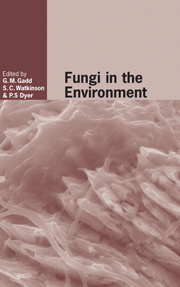Book contents
- Frontmatter
- Contents
- List of contributors
- Preface
- I Imaging and modelling of fungi in the environment
- II Functional ecology of saprotrophic fungi
- III Mutualistic interactions in the environment
- IV Pathogenic interactions in the environment
- V Environmental population genetics of fungi
- 15 Fungal species: thoughts on their recognition, maintenance and selection
- 16 Multilocus sequence typing (MLST) and multilocus microsatellite typing (MLMT) in fungi
- VI Molecular ecology of fungi in the environment
- Index
- References
16 - Multilocus sequence typing (MLST) and multilocus microsatellite typing (MLMT) in fungi
from V - Environmental population genetics of fungi
Published online by Cambridge University Press: 03 November 2009
- Frontmatter
- Contents
- List of contributors
- Preface
- I Imaging and modelling of fungi in the environment
- II Functional ecology of saprotrophic fungi
- III Mutualistic interactions in the environment
- IV Pathogenic interactions in the environment
- V Environmental population genetics of fungi
- 15 Fungal species: thoughts on their recognition, maintenance and selection
- 16 Multilocus sequence typing (MLST) and multilocus microsatellite typing (MLMT) in fungi
- VI Molecular ecology of fungi in the environment
- Index
- References
Summary
What is multilocus typing?
Origins of the technique
The characterization of genetic variation has revolutionized our understanding of fungal populations and species. Traditionally, advances have been most rapid in the fields of medical mycology and phytopathology (Taylor et al., 1999b) owing to the need for effective molecular epidemiological tools. Epidemiological studies are typically concerned with disease outbreaks, the origin and spread of virulent strains, or the emergence of an interesting phenotype such as antibiotic resistance. Genetic variation in the genomes of pathogens provides a means by which isolates can be differentiated from one another (Taylor et al., 1999b). The characterization of this molecular variation has given rise to the field of molecular epidemiology, whereby genetic variation is used to address questions about the biology and transmission of infectious diseases. However, the techniques developed for molecular epidemiology are not limited to medical fields, and there is huge potential to apply these methodologies to non-disease-causing organisms.
The power of molecular epidemiology as an analytical tool has led to a period of rapid development, resulting in many methods for indexing genetic variation, such as VNTRs (variable number tandem repeats), MLEE (multilocus enzyme electrophoresis), RFLPs (restriction fragment length polymorphisms), RAPDs (randomly amplified polymorphic repeats) and PFGE (pulse field gel electrophoresis), to name but a few (Taylor et al., 1999b; McEwen et al., 2000). Typically, laboratories have tended to develop in-house techniques that are specifically focused on a particular problem, and are usually a variant on the above.
- Type
- Chapter
- Information
- Fungi in the Environment , pp. 340 - 354Publisher: Cambridge University PressPrint publication year: 2007



